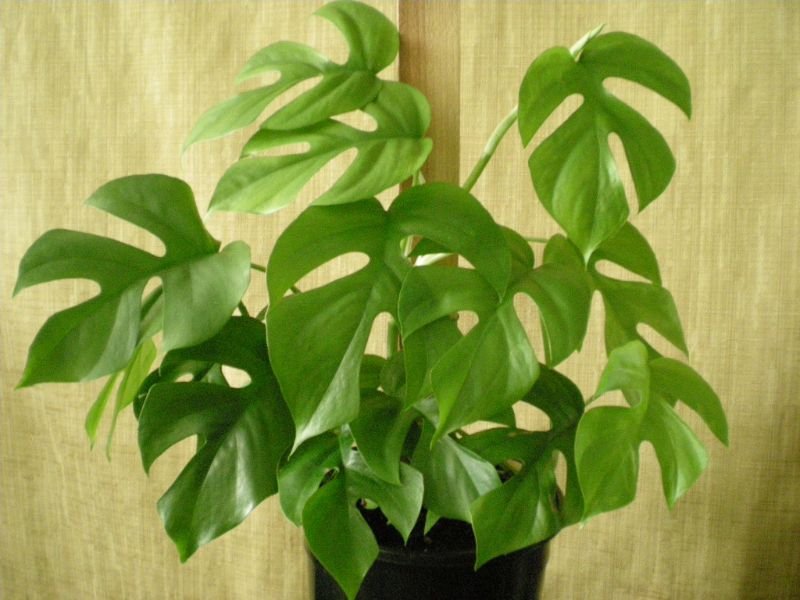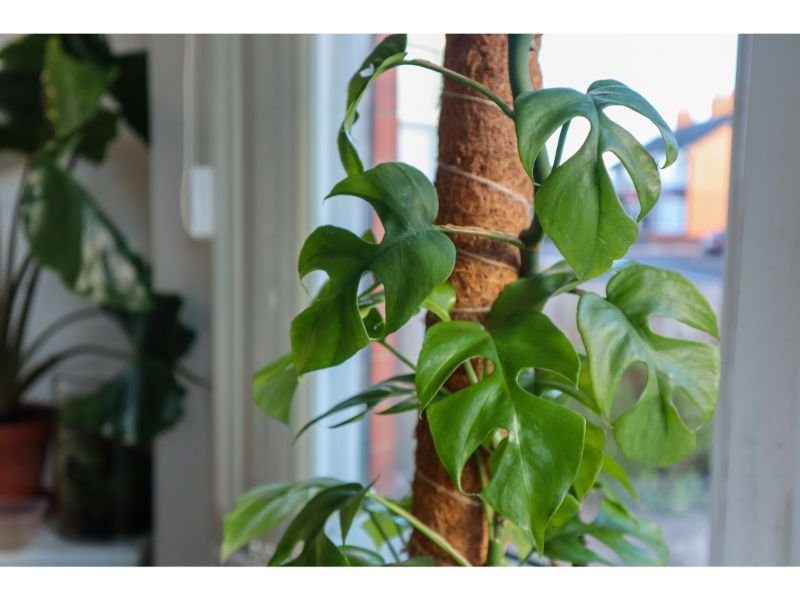Mini monstera, also known as Rhaphidophora tetrasperma, is a small-sized foliage plant that has gained a lot of spotlight due to its resemblance to Monstera Deliciosa, although they’re two different plants. Aside from their unique shape and glossy foliage, the popularity of mini monstera can be attributed to their maintenance–where mini monstera plant care is relatively easy and can be done by gardeners on any level.

If you’re curious about how to make a mini monstera an eye-catching addition to any room, here’s all you need to know about the mini monstera care.
Table of Contents
Plant Info
Common Name(s): Miniature Monstera, Dwarf Monstera, Ginny Philodendron, Philodendron Piccolo, Monstera Pertusa
Scientific Name: Rhaphidophora tetrasperma
Family: Arums (Araceae)
Country of Origin: Ranging from Southern Thailand to Malaysia
Natural Habitat: Dry to moist tropical rainforests climate
Size: Approximately 5 to 9 feet (1.5 to 2.7 meters) indoors, 14 to 20 feet (4.2 to 6 meters) outdoors
Toxicity Level: This plant is toxic for both humans and pets
Color(s): Dark green, bright lime green
Flower Shape: White or pale yellow spathe with a bright or pale yellow spadix
Basic Plant Requirements
Zones: 9 to 12
Light: Bright, indirect
Watering: Regular weekly watering with frequent misting to keep the plant moist
Soil pH: Slightly acidic to neutral (5.5 to 7.0)
Humidity: High, 60% to 90%
Temperature: About 65 to 80 Fahrenheit (18 to 26 Celsius)
Fertilizing: Once to twice a month regularly during the growing season
Recommended Propagation Method(s): Stem cuttings
Repotting: Best before the growing season
Pruning: As needed
What’s Special About Mini Monstera Plant?

Aside from the easiness of mini monstera plant care, mini monsteras are favored for their unique appearance, with foliage that is shaped like a split arrowhead and perforations along the edges, giving the plant a more textured look. As the name indicates, mini monstera is also ‘fun-sized’, making them perfect for those who have limited space but would like to incorporate lush foliage plants similar to Monstera Deliciosa. Mini monstera also has the ability to purify and absorb toxins from the air.
Foliage and Blooms Appearance
Mini monstera is mainly grown for its foliage, which can grow about 6 to 8 inches (15 to 20 centimeters) each. It is shaped like an arrowhead with deep splits. Although rarely blooming, especially if grown indoors, mini monstera produces relatively small blossoms, with pale or bright yellow and white spathe and a long, slender white or yellow spadix–similar to Monstera Deliciosa’s blooms.
Size and Growth
Even though mini monstera is considered small, this beautiful plant is a rapid grower which can grow massively if left untamed and given more space to grow. They grow to about 20 feet (6 meters) or more outdoors, but are often grown as indoor ornamental house plants to a maximum height of about 6 feet (2 meters).
Do Mini Monstera Plants Have Fragrance?
No, mini monstera plants do not have a noticeable fragrance and are primarily grown for their lush foliage shape.
How To Avoid the Toxicity of Mini Monstera Plants?

All aroids, including mini monstera plants, are toxic and contain chemicals such as alkaloids and calcium oxalate crystals located in their sap. If the sap is accidentally ingested or touched, it can cause symptoms like irritation, nausea, vomiting, and diarrhea.
To avoid the potential toxicity of mini monstera plants, the first thing you are going to do is to wear protective gloves before touching the plants, e. g. for pruning or repotting purposes and make sure to always wash your hands right after. Keep the plant away from children, the elderly, and pets, and immediately seek medical attention if necessary.
What Can You Do With Mini Monstera Plants?
Aside from being an excellent choice to add some greenery and visual interest to your indoor or outdoor gardens, mini monstera can be trained to grow as climbing or vining plants. When grown outdoors, mini monstera can also be used as ground-covering plants to cover shady areas. In addition to the ease of mini monstera plant care, mini monstera is also rather easy to propagate, and you can use the newly propagated plants as a gift for family members or friends.
Mini Monstera Plant Care Guide

Light
One of the most crucial things about mini monstera plant care guides is to provide them with adequate light to thrive. To mimic their natural habitat, mini monstera needs bright but indirect light and can tolerate a few hours of bright, direct early morning or late afternoon light where it’s not too warm for the plant. To grow them indoors, it’s best to place them near a bright window. You can supplement the mini monstera plant’s light needs with grow lights for houseplants if necessary.
Watering
Another important step to note about mini monstera plant care is watering. Although naturally came from tropical rainforests, mini monstera prefers moist over wet, soggy soil. Give them well-draining soil and water only when the first topsoil feels dry.
Avoid overwatering and water thoroughly until the water reaches out to the very bottom part of the soil. Adjust your watering schedule based on weather, temperature, humidity, and light. Decrease the amount of watering in winter or cold season, when the plant usually goes dormant.
Temperature and Humidity
Naturally a warm-climate tropical plant, the mini monstera loves warmer temperatures with high humidity to thrive, making it the next principal key to add to your mini monstera plant care routine. Make sure the temperature is always between 65 to 80 Fahrenheit or 18 to 26 Celsius, as sudden temperature changes may ‘shock’ the plant. Too warm or too cold temperatures are both dangerous for mini monstera.
For humidity, mini monstera loves environments with high humidity levels, ranging from about 60% to 90% (the more humid it is, the better). You might want to add regular misting to the routine, or placing the plant near any other house plants would also help to increase humidity. In the drier season, make use of a humidifier or remove the mini monstera to a more humid area to increase the humidity level.
Soil
When talking about mini monstera plant care, providing the right soil is just as paramount as providing the best light, watering, and humidity, as soil provides nutrients directly to the plant. Mini monstera adores well-draining soil with a pH of slightly acidic to neutral. A good potting soil mix that is specially made for aroids added with coco peat, moss, and perlite is also great to help you add drainage. Avoid using soil that contains too much clay.
Fertilizing
Fertilizing is needed to promote the mini monstera plant’s growth, but too much fertilizer can do more harm than good, so it’s crucial to know when to fertilize the plant. The best time to fertilize mini monstera is during their growing season, which is from early spring to summer.
Do not fertilize the plant in winter. Use balanced fertilizers with adequate amounts of nitrogen, phosphorus, and potassium. Organic fertilizers made from coffee grounds, crushed eggshells, and worm castings also do wonders. Apply the fertilizer only to the soil and avoid the fertilizer getting to the leaves and stems.
Propagation
The recommended propagation method for mini monstera is through stem cuttings. To make sure you succeed in this process, always choose the most healthy, mature stems to do the process. Use clean, sterilized gardening shears or scissors to cut the stem just below the nodes. Plant the stem cutting in a new pot with moist and well-draining, rich soil. Once the stem cutting has developed roots, you can move the new plant to a new and bigger pot or container.
Repotting and Pruning
As the healthy mini monstera keeps growing, the plant surely will outgrow its growing space, and that’s where you need repotting. Usually, mini monstera needs to be repotted every once or twice a year to avoid root binding. Meanwhile, pruning is crucial to keep away the diseased and dead stems or foliage, to keep the mini monstera in shape, and also to encourage the plant’s growth. The best time to do repotting and pruning is before or during the growing season.
Common Diseases and Pets
The mini monstera care guide is not complete if we don’t discuss common diseases and pets, as like any other house plants, they are prone to these issues. Some common pests and diseases include but are not limited to root rot, stunted growth, yellowing or browning leaves, leggy growth, spider mites, mealy bugs, and fungal leaf spots. Make sure to provide them with the right growing conditions or use commercially available neem oil, horticultural oil, and insecticidal soap to help heal the plant.
Mini Monstera Care In A Nutshell
Generally, mini monstera plant care is easy and not demanding. The three principal keys are to give them bright and indirect light, moist and well-draining soil with high humidity, and warm temperature with a minimum of 65 Fahrenheit (18 Celsius). With all these things in mind, you can make sure that the plant is growing healthily and happily.

New author in the hood. Loves gardening and flowers are my spirit animals (yes I know they are not animals but I insist). I will be covering most of the flowers’ topics here and occasionally random though as well.






